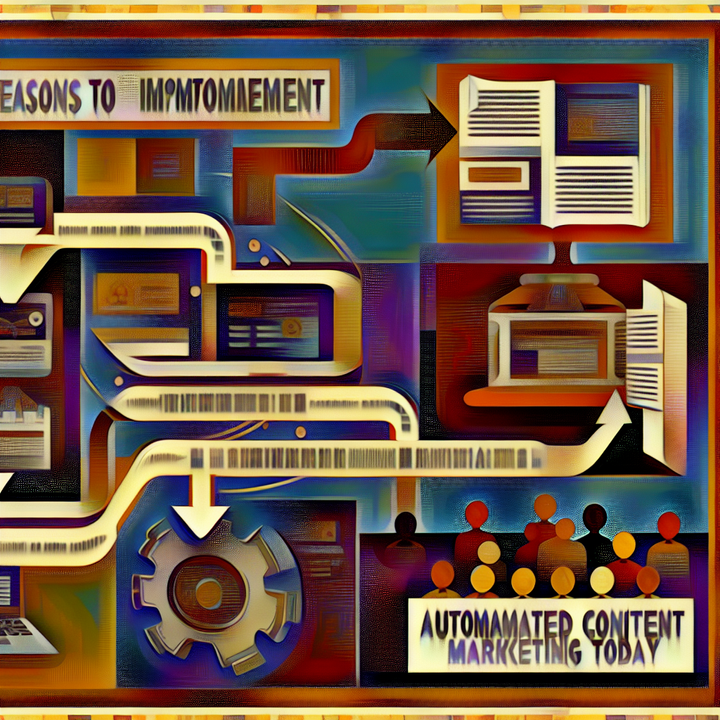The Role of Automation in Measuring Content Success

Understanding the Importance of Measuring Content Success
In an era where content marketing is pivotal for business growth, measuring the success of your content campaigns is crucial. Data-driven insights can shape your content strategy, leading to increased traffic, better engagement, and higher conversion rates. But, why exactly is it so important to measure the success of your content marketing efforts?
First, understanding what works and what doesn't allows you to refine your approach continually. Data can reveal which topics resonate best with your audience, the types of content that drive the most engagement, and the channels most effective for distribution. Without these insights, your content strategy would be akin to sailing without a compass.
However, measuring content success manually is fraught with challenges. The process is time-consuming, often involving sifting through vast amounts of data across various platforms. Additionally, manual tracking is prone to errors, leading to inaccurate insights. More critically, the lag in data retrieval and analysis can result in missed opportunities for timely content adjustments.
By embracing automated tools for content measurement, businesses can overcome these challenges and maximize the impact of their content marketing initiatives.
The Benefits of Using Automated Tools for Content Measurement
Automated tools bring a world of advantages to content measurement. Here’s how:
- Efficiency: Automation streamlines the process, saving significant time and effort. Tools can quickly aggregate data from various sources, making it accessible at the proverbial click of a button.
- Accuracy: Automated systems minimize human error in data collection and analysis. This leads to more reliable insights that can steer strategic decisions.
- Real-Time Insights: Unlike manual tracking, which can lag behind real-world events, automated tools offer real-time data. This immediacy allows businesses to react swiftly to trends and adjust their strategies on the fly.
- Resource Allocation: With the heavy lifting taken over by automated systems, teams can focus on crafting compelling content and strategizing rather than drowning in data.
By leveraging content marketing automation, businesses can enhance their capabilities and gain a competitive edge through timely, accurate, and comprehensive insights.
Key Metrics to Track with Automated Tools
Knowing which metrics to track is essential to measure the success of your content. Here are key metrics that should be on your radar:
| Metric | Description |
|---|---|
| Organic Traffic | The number of visitors arriving at your website through non-paid search engine results. High organic traffic indicates strong SEO performance and content relevance. |
| Bounce Rate | The percentage of visitors who leave your site after viewing just one page. A high bounce rate can signal content or design issues that need attention. |
| Conversion Rate | The percentage of visitors who take a desired action, such as filling out a form or making a purchase. This metric reflects the effectiveness of your content in driving desired outcomes. |
| Social Engagement | Metrics like likes, shares, and comments on your social media posts. Social engagement metrics can indicate how well your content resonates with your audience. |
| Backlink Profiles | The number and quality of external sites linking to your content. High-quality backlinks improve SEO and significantly enhance content credibility. |
Tracking these metrics with automated tools provides straightforward, actionable insights that can guide continuous improvement in your content strategy.
Popular Automated Tools for Measuring Content Success
Several powerful automated tools can assist in measuring content success. Here are some worth exploring:
- Google Analytics: An essential tool for understanding website traffic, user behavior, and conversion rates. It offers comprehensive insights into how visitors interact with your content.
- SEMrush: Known for its robust SEO capabilities, SEMrush also offers detailed analytics on organic search performance, keyword tracking, and backlink profiles.
- Ahrefs: This tool excels in providing insights into organic search traffic and backlink analysis. It's invaluable for competitive analysis and content gap identification.
- HubSpot: A versatile tool that combines content analytics with CRM capabilities, allowing you to track the entire customer journey from awareness to conversion.
- Taleflow: Our own content performance tracking features provide automated insights into blog and newsletter effectiveness, helping you optimize your strategy effortlessly.
These tools offer unique benefits and can be combined to create a comprehensive content measurement system tailored to your needs.
Real-World Examples of Automation in Content Performance Tracking
Let's look at some real-world examples of how businesses have successfully used automation for content performance tracking:
Case Study: E-commerce Retailer
An e-commerce retailer integrated automated tools to track their content's performance. By leveraging SEMrush and Google Analytics, they identified underperforming blog posts and optimized them with targeted keywords. The result was a 25% increase in organic traffic within three months.
Case Study: B2B Software Company
A B2B software company utilized HubSpot's automated tools to measure the effectiveness of their whitepapers and case studies. They discovered that content shared via LinkedIn had a significantly higher conversion rate. This insight helped them reallocate their marketing budget more effectively and boost lead generation by 15%.
These examples highlight the tangible benefits of using automation to track and measure content performance.
Actionable Insights from Automated Data Analysis
The beauty of automated data analysis lies in its ability to offer actionable insights, enabling you to refine your content strategy continuously. Here’s how different personas can leverage these insights:
- Business Owners: Can use conversion metrics to validate content investment and steer overall business strategy.
- Marketing Managers: Social engagement metrics help guide promotional strategies and identify collaboration opportunities.
- Content Strategists: Organic traffic and bounce rate data inform the creation of user-centric content that drives engagement.
- Startup Founders: Can leverage insights from multiple metrics to pivot quickly and optimize limited resources for maximum impact.
Automated tools provide quantified data, which can be tailored to deliver actionable insights for diverse business roles, enhancing overall strategic efficiency.
Integrating Taleflow’s Automated Blogging and Newsletter Services
At Taleflow, we offer automated blogging and newsletter services designed to streamline content creation and distribution. Our platform simplifies the entire content marketing process, allowing businesses to focus on what they do best.
Our automated blog service crafts SEO-optimized content tailored to your industry and target audience. Similarly, our newsletter automation ensures your email campaigns are timely, relevant, and effective. We also provide content performance tracking features that offer real-time insights, allowing you to adjust your strategy as needed.
By integrating Taleflow’s solutions, businesses can effortlessly enhance their content marketing efforts, improve SEO, and track performance—all without the need for extensive resources or time.
Future Trends in Content Measurement and Automation
The future of content measurement and automation is promising, driven by advancements in technology and data analytics. Here are some trends to watch:
- AI and Machine Learning: Expect more sophisticated algorithms that can predict content performance and offer personalized recommendations for optimization.
- Integrated Platforms: The convergence of CRM, CMS, and content analytics platforms will offer more seamless and comprehensive insights.
- Predictive Analytics: Tools that can predict content trends and user behavior will become essential for proactive content strategies.
- Voice and Visual Search Optimization: With the rise of voice assistants and visual search technologies, new metrics will emerge to measure content success in these areas.
Staying updated with these trends will help businesses maintain a competitive edge and continually refine their content marketing strategies.
By embracing automation tools, tracking key metrics, and staying ahead of future trends, businesses can significantly enhance their content marketing efforts and achieve measurable success.



